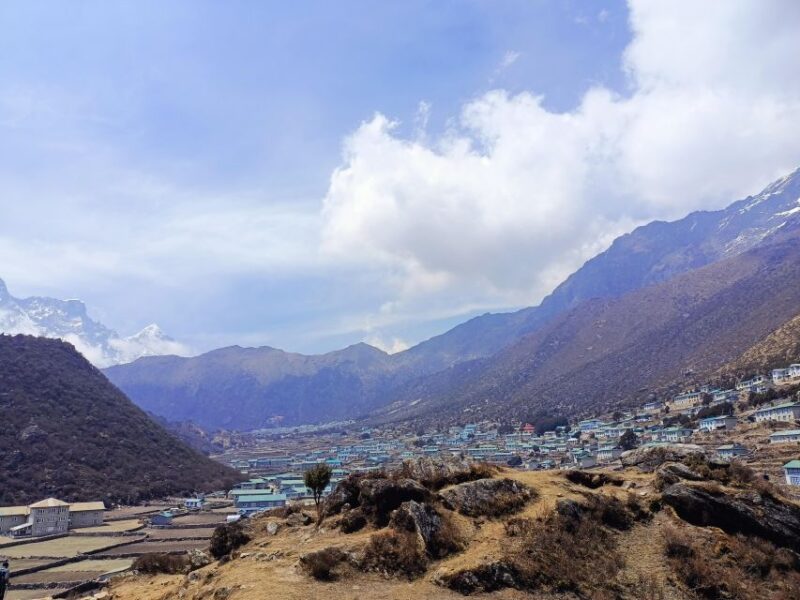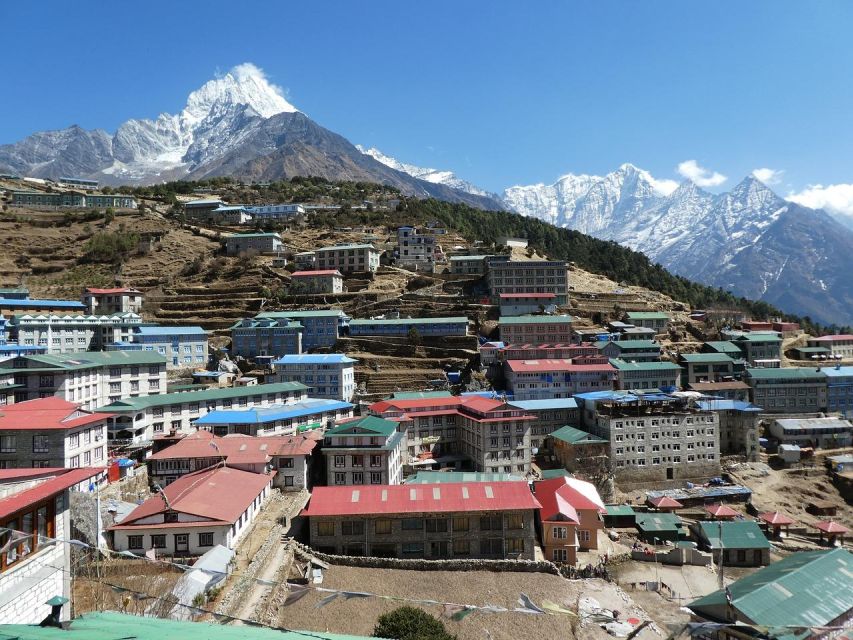The Everest Panorama Trek is a captivating journey that offers trekkers a unique blend of breathtaking landscapes and rich cultural experiences. Over five days, participants traverse the enchanting trails of Sagarmatha National Park, capturing views of iconic peaks like Everest and Lhotse. Along the way, they’ll encounter traditional Sherpa villages and lush rhododendron forests, making it an ideal choice for those who appreciate nature and culture alike. But what truly sets this trek apart are the hidden gems and stories waiting to be uncovered in each village, creating an experience that promises to resonate long after the trek is complete.
Key Points

- The Everest Panorama Trek offers stunning views of iconic peaks like Everest, Lhotse, and Ama Dablam.
- This 5-day trek provides a rich cultural experience, immersing trekkers in Sherpa traditions and village life.
- Key highlights include the Hillary Bridge, rhododendron forests, and a stay at the Everest View Hotel for panoramic vistas.
- Ideal trekking seasons are Spring (March to May) and Autumn (September to November) for optimal weather and visibility.
- The trek is suitable for small groups of up to 10 participants, fostering camaraderie and personalized attention.
Trek Overview and Highlights

The Everest Panorama Trek offers adventurers a breathtaking glimpse into the majestic Everest region, making it perfect for those with limited time or seeking a less strenuous trekking experience.
This condensed trek showcases stunning views of iconic peaks like Everest, Lhotse, and Ama Dablam, all while immersing trekkers in the rich Sherpa culture.
As they traverse diverse landscapes, hikers are treated to enchanting rhododendron forests and the picturesque Sagarmatha National Park.
Highlights of the trek include the thrilling Hillary Bridge and a stay at the Everest View Hotel, where panoramic vistas captivate the senses.
With its blend of natural beauty and cultural richness, the Everest Panorama Trek promises an unforgettable experience for all who embark on this adventure.
You can also read our reviews of more tours and experiences in Lukla.
Detailed Itinerary

On Day 01, trekkers fly to Lukla and embark on a 4-hour trek to Phakding, gradually seeing the stunning landscapes of the Everest region.
The next few days unfold with a carefully planned itinerary:
-
Day 02: Trekkers tackle a 6-hour hike to Namche Bazaar, the gateway to Everest.
-
Day 03: An acclimatization day allows for exploration, including a hike to the Everest View Hotel or Khumjung Village.
-
Day 04: The return trek to Lukla takes about 6 hours, providing a chance to reflect on the journey.
-
Day 05: Finally, trekkers fly back to Kathmandu, filled with unforgettable memories of their adventure.
Duration and Group Size

Spanning just 5 days, the Everest Panorama Trek is designed for small groups, accommodating up to 10 participants for a more personalized experience.
This compact duration makes it perfect for those with limited time or seeking a less strenuous adventure.
Each day unfolds new opportunities to absorb breathtaking mountain vistas and immerse in Sherpa culture.
The small group size fosters camaraderie while ensuring everyone’s needs are met throughout the trek.
Participants can engage with their guide more effectively, enhancing the overall experience.
With a carefully crafted itinerary, trekkers enjoy ample time to explore scenic landscapes and local traditions without feeling rushed, creating lasting memories amid the grandeur of the Everest region.
Inclusions of the Trek
Included in the Everest Panorama Trek are essential services and amenities that ensure a smooth and enjoyable experience for all participants. The trek provides the following inclusions:
-
Airport pickup and drop from the hotel to facilitate seamless travel.
-
Professional government licensed guide who enhances safety and enriches the trekking experience with local insights.
-
Accommodation during the trek, ensuring comfort and rest after daily adventures.
-
Required permits, including the Khumbu Rural Municipality Fee and Sagarmatha National Park Permit, taking care of all necessary paperwork.
Plus, the package covers food, accommodation for the guide, and government taxes, making the trek well-rounded and accessible for everyone.
Participants can focus on the breathtaking scenery and cultural experiences without worrying about logistics.
More Great Tours NearbyExclusions and Suitability
While the Everest Panorama Trek offers a wealth of inclusions, participants should be aware of certain exclusions that may arise during their journey.
Personal expenses, such as meals and drinks, aren’t covered, so trekkers should budget accordingly. Plus, the cost of the flight to and from Lukla is excluded, along with tips for the guide and travel insurance.
Those with a history of altitude sickness may find this trek unsuitable, as the elevation can pose challenges. It’s essential for participants to prepare adequately and consider their health.
For peace of mind, the trek includes a free cancellation policy up to 24 hours in advance, allowing trekkers to adjust their plans if needed.
Best Time to Trek
Understanding the best time to trek is vital for maximizing the experience on the Everest Panorama Trek, as weather conditions play a significant role in the trek’s enjoyment and safety. The ideal trekking seasons are spring and autumn, when the weather is generally stable. Trekkers should consider the following factors:
-
Spring (March to May): Clear skies and blooming rhododendrons create stunning views.
-
Autumn (September to November): Cooler temperatures and less rain, offering crisp air and great visibility.
-
Monsoon (June to August): Heavy rains can lead to landslides and muddy trails, making this season less favorable.
-
Winter (December to February): Cold temperatures and snow risks can hinder accessibility.
Choosing the right time ensures a memorable trekking adventure.
Packing List Essentials
What essentials should trekkers pack for the Everest Panorama Trek to ensure comfort and safety throughout their adventure?
First, sturdy trekking boots are a must, providing support and traction on varied terrain.
Layered clothing, including moisture-wicking base layers, insulation, and a waterproof jacket, helps manage temperature changes.
Don’t forget a warm hat, gloves, and a buff for cold conditions.
A solid backpack, hydration system, and snacks keep energy levels up during the trek.
Trekking poles can ease the strain on knees and improve stability.
Essential personal items include a first-aid kit, sunscreen, and a headlamp.
Cultural Experiences During Trek
Trekkers on the Everest Panorama Trek enjoy the rich Sherpa culture, experiencing vibrant traditions and warm hospitality along the trail. They encounter a unique blend of customs and practices, enhancing their trekking adventure.
Key cultural experiences include:
-
Sherpa Villages: Exploring the traditional architecture and daily life in villages like Namche Bazaar.
-
Buddhist Monasteries: Visiting ancient monasteries, such as the one in Tengboche, and observing prayer rituals.
-
Festivals and Celebrations: Experiencing local festivals, which showcase traditional dances, music, and food.
-
Local Cuisine: Tasting authentic Sherpa dishes, like momos and dal bhat, which offer a glimpse into the region’s culinary heritage.
These experiences not only enrich the trek but also foster a deeper understanding of the Sherpa way of life.
Frequently Asked Questions

What Fitness Level Is Required for the Everest Panorama Trek?
For this trek, a moderate fitness level’s recommended. Participants should enjoy hiking, walk regularly, and handle elevation changes comfortably. It’s not overly strenuous but will still challenge those unaccustomed to physical activity at altitude.
Are There Age Restrictions for Participants on This Trek?
There aren’t strict age restrictions for participants, but individuals should assess their fitness and health. Generally, younger trekkers thrive alongside older adventurers, as long as everyone’s prepared for the trek’s demands and challenges.
How Do I Prepare for Altitude Sickness?
To prepare for altitude sickness, he should acclimatize gradually, stay hydrated, and avoid strenuous activities. Eating light meals and consulting a doctor about medications can also help him manage potential symptoms effectively.
What Should I Do in Case of an Emergency During the Trek?
In case of an emergency during the trek, she should remain calm, assess the situation, and alert her guide immediately. They’ll provide guidance and assistance, ensuring her safety while following established emergency protocols.
Can I Customize My Trekking Itinerary or Extend My Stay?
Yes, travelers can customize their trekking itinerary or extend their stay. They should discuss their preferences with the trekking company, which often accommodates individual requests to enhance the overall experience and enjoyment.
Recap
To sum it up, the Everest Panorama Trek offers a unique blend of breathtaking landscapes and rich Sherpa culture.
With its well-planned itinerary, trekkers get to experience the majestic peaks and charming villages in just five days.
Whether you’re a nature lover or a cultural enthusiast, this trek has a lot to offer.
By choosing this adventure, trekkers not only create unforgettable memories but also gain a deeper appreciation for the stunning beauty and heritage of the Everest region.
You can check availability for your dates here:More Hiking & Trekking Tours in Lukla
More Tour Reviews in Lukla
Not for you? Here's more nearby things to do in Lukla we have reviewed
- Everest Heli Sightseeing Tour
- Mera peak trek
- Everest Base Camp Helicopter Landing Tour from TIA – 1 Day
- Everest Base Camp Trek – 6N/7D
- Nepal: Mera Peak Expedition with Trekking and Climbing
- Everest Scenic Mountain Flight (Review Exclusion Section)
- 16-Day Mera Peak Climbing Expedition
- 9 Best Tours In Lukla
- 24 Best Treks And Hiking Tours In Lukla
- 11 Best Helicopter Flights And Tours In Lukla
- Everest Base Camp Trek
- Kathmandu to Ramechhap Manthali Transfer – Sharing Vehicle
